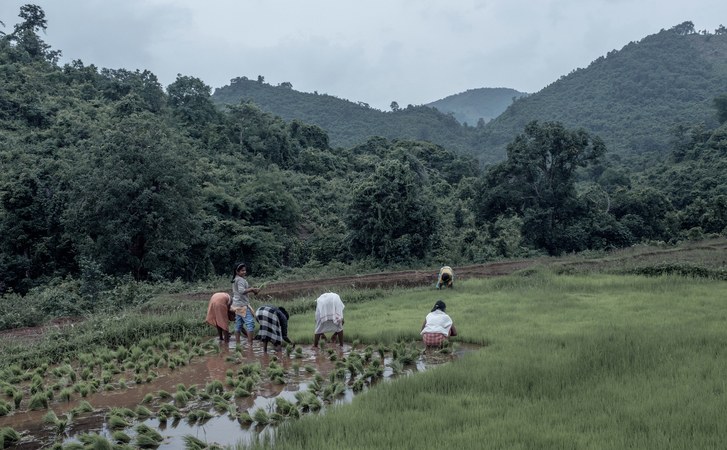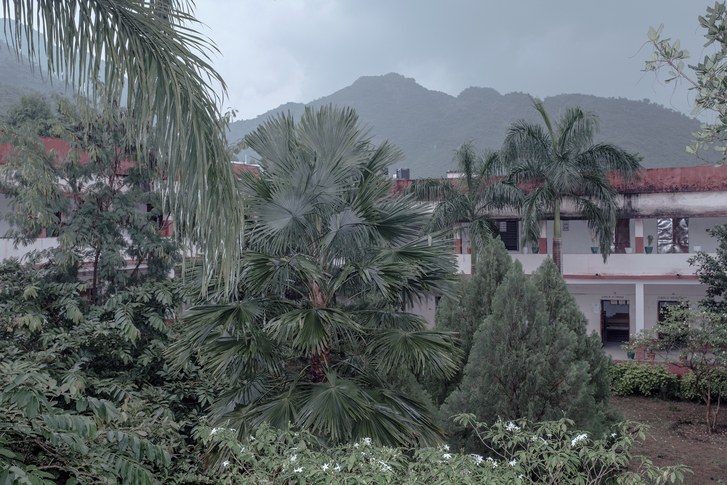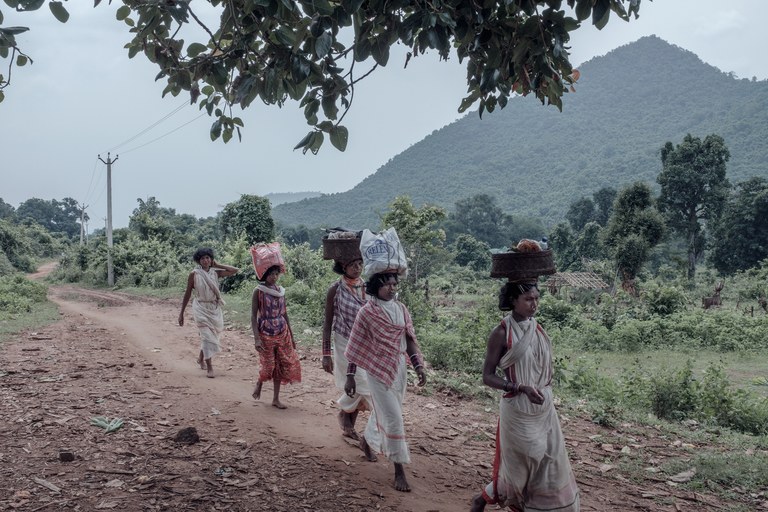Photography by Arko Datto

Outside a Dongria village in the Niyamgiri hills
In the summer of 2017, two young women from the Dongria tribe, which lives in the remote hills of Niyamgiri, in the state of Odisha, in eastern India, made separate journeys to the town of Rayagada, presaging two different futures for their people. Purnima Huika, who was sixteen, wore her hair in a neat braid. She was joining four hundred other students, all from indigenous communities in Odisha, at a new high school, where she would be living and studying science. Kuni Sikaka, who was twenty, wore a small, curved knife tucked into her side bun. She was being taken to police headquarters, to be made to surrender as an outlaw.
Purnima, whose born name is Pukutti, comes from a hamlet deep in the forests of Niyamgiri, where her tribe has lived for centuries, rarely venturing beyond the market towns at the foot of the range. As a small child, she helped her mother sow the dongar, the shifting hillside plots from which the Dongria take their name. They grew millet, bananas, and beans, and at night the children watched for animals—wild dogs, bison, sloth bears, and sometimes tigers. For the Dongria people, “the mountain is God’s abode,” Purnima told me recently. “For many generations, we’ve worshipped these hills, streams, and trees.”
There was no school near the family’s home, and Purnima, like many Dongria children, at first received no formal education. The year she turned seven, an official of the Dongria Kondh Development Agency arrived to enroll tribal children in an Ashram, a new government-run residential institution down in the plains. Purnima’s parents did not want her to leave, and they refused to let her go, until the official promised them rations of rice from the local council.

Monsoon showers at the Eklavya Model School in Rayagada.
At school, Purnima was given new clothes and her new name, Sanskrit for “full moon.” She ran away in the middle of term, “and came home without telling anybody.” For two years, she was pulled back and forth, between home and school, until “slowly,” she said, “I started to like that environment.” She learned to love math, and in 2017 she and thirteen others became the first women of their tribe to complete the tenth grade. A report in the Hindustan Times called them role models, saying they represented a future of assimilation for one of the state’s “most primitive and backward” tribes. Purnima, who had the best grades in the group, was recruited to the Eklavya Model School in Rayagada, a premium residential high school run by the national Ministry of Tribal Affairs.

Purnima in the chemistry lab.
In another village, at the opposite end of Niyamgiri, Kuni Sikaka had a childhood similar to Purnima’s. In 1997, the year she was born, the government of Odisha signed an agreement with a U.K.-based mining firm, Vedanta Resources, to build an aluminum refinery in the plains near Kuni’s home, and to mine the hills for bauxite, the ore that yields the main ingredient of aluminum. The Dongria opposed the project, and tribal women were in the forefront of the struggle against it. By her teen years, Kuni was helping, hiking from one hamlet to the next with her father to advocate for the resistance. The protests made international news, boosted by their apparent likeness to the story told in the movie “Avatar,” which was nominated for the Academy Award for best picture in 2010. (“Is a Tribe in India the Real-Life Na’vi?” Time magazine asked.) Niyamgiri served as a luminous stand-in for real ecosystems around the world that indigenous people are defending from extractive industries.
In 2013, India’s Supreme Court ruled that, as a Particularly Vulnerable Tribal Group, the Dongria could settle the question of Vedanta’s mineral rights with a referendum vote among the village councils. The ruling overturned a prerogative the Indian government had reserved since the colonial era, allowing it to dictate the use of forest lands without consulting the people who had historically lived on them. The twelve villages voted unanimously against the company’s proposal. A wary peace resumed in Niyamgiri, and in Kuni’s life. In the spring of 2017, she married Jagili Pusika, whom she had met in the movement. The young couple were regarded as spokespeople of the new generation for the tribe and its native lands.

Kuni Sikaka. Courtesy Raghu Karnad
One night in early May last year, Kuni was asleep in the home of her new in-laws when members of India’s Central Reserve Police Force crept up to their village, Gorata, to arrest her. Kuni says she awoke to the sound of a girl crying, “The police are here!” Then armed men were in the house, hustling her family into the night. Kuni was seized by women constables, who forced her down the trail leading out of the village, to where a convoy of trucks and S.U.V.s were idling.
The morning after her arrest, Kuni’s husband, Jagili, learned that she was being held on the accusation of aiding the Maoists, a guerilla group doing battle with the state in the jungles of central India, including in Odisha, largely in opposition to the expropriation of tribal lands. Kuni would be released if she “surrendered” under terms offered by a new scheme to rehabilitate left-wing extremists. By the time Jagili got down to the Rayagada police headquarters to bring her home, Kuni told me she had placed her thumbprint, standing in for a signature, on a number of documents she could not read. On May 3rd, Kuni and five others—Jagili, his father, and three men from Gorata who accompanied them—were presented to a room of news photographers as surrendered extremists. Kuni, the press release said, was “hardcore cadre.” Kuni denies either associating with Maoists or making any voluntary confession. In an e-mail, Rahul P. R., the Superintendent of Police in Rayagada, told me, of Kuni, “It is understood that she is under pressure from Maoists and members of Niyamagiri Surakhya Samiti”—the Niyamgiri Defense Committee, the leading Dongria activist organisation—“to conceal the actual incident and present a distorted version implicating police.”

Dongria women returning from the market at the foot of the Niyamgiri hills.
To close observers of the struggle, Kuni’s arrest is a signal that Vedanta, emboldened by the corporate-friendly national government of Narendra Modei, is setting up a new play for the bauxite in Niyamgiri. To Kuni herself, however, and to others in her tribe, the threat is not that they will be driven off their land but that they will be drawn off of it, like Purnima was, one child at a time.
“Our people are alert to the cause of our land. If the situation demands, we will rise up again,” Kuni told me, and later added, “Our fear is that so-called education will uproot our people. The companies know that ‘educated’ people want to leave. They want jobs elsewhere. That’s why they take our children so far away.”

A Dongria village in the Niyamgiri hills.
When I spoke to Kuni in March, she was resting with other Dongria women in the shade of a neem tree, on her way back from a weekly market at the eastern foot of the hills, where they sell or barter forest produce for sweet biscuits, fried snacks, bread, salt, soap, and matches. Kuni, who is not quite five feet tall, was covered in the ornaments that identify the women from her tribe: a dozen rings in each ear, a sunburst of bobby-pins, necklaces, and the triple nose-ring that signifies the tribe’s “niyam,” or law—an ancestral mandate to protect their forest world. She had tattoos on her chin and brow, the latter in the shape of a “V,” a symbol for a sprouting bamboo. Kuni cannot read, but she is fluent in argument and dry in her sense of humor. “In our village, we have a saying, not really serious, that if you read you become a servant of the company; if you don’t read, you stay a master of your land,” Kuni said.
“Some of my village-folk have jobs in cities now,” she said, casting a side-eye in the direction of the market. “It’s a bit of a problem even recognizing them.”

Assembly and morning prayers in the school playground.
At the Eklavya Model School, for instance, where Purnima is wrapping up eleventh grade, she wears a white shalwar kameez with bright white sneakers. The physical marks of her tribe are fading: Faint tattoos remain on her chin, but the piercings in her nostrils have closed over since she took out her nose-rings to fit in at the Ashram. Purnima, like Kuni, speaks a tribal dialect of the regional language, Odia, which was translated for me into Hindi by an interpreter. (Purnima is studying both languages at school.) Her aim, she told me, is to become a teacher herself—only about three per cent of Dongria women are considered literate, and there’s much else they need to learn. “I respect the beliefs of the tribe,” she said. “But, personally, I think we have to increase harvests by putting in more effort—not by sacrificing animals and all those old rituals alone.”
Purnima told me that she’d like to go home and teach in her native village, though there is still no school there, nor likely to be one anytime soon. For the government, a corollary of the residential-education program is decommissioning day schools. In 2016 and 2017, Odisha shut down eight hundred and twenty-eight village primary schools, which it said were under-enrolled; the district of Rayagada alone lost a hundred and twenty-four schools. In these villages, parents choose between sending children away or rejecting schooling for them altogether.

Purnima and her classmates in the physics lab.
“We are almost imposing schooling on their culture,” Poonam Guha Tapas Kumar, Rayagada’s top bureaucrat, told me one afternoon, sitting in her heavily air-conditioned office in the town center. “But somewhere or the other we have to impose. We cannot allow them to forsake our future, that is our children.” Kumar described a triple challenge to delivering public services in the area: the rugged topography, the threat from Maoists, and the intransigence of tribal families. “These are extremely backward communities,” she said, “still believing in witchcraft, still believing in child marriage. These are the banes of this part of the district. Health, hygiene, nutrition—everything is a concern.”

Wood gatherers take their goods to the market.

Members of the Dongria tribe returning home from the market.
Running day schools, as the state does elsewhere in the country, is especially tricky, Kumar said, given the truant disposition of both teachers and tribal children. Residential schools are perceived as guaranteeing better results. The Ashram system, which has existed in some form for more than a century, has expanded rapidly in recent years, coinciding with India’s intensified armed campaign against the Maoists. In Rayagada alone, the state has fifty-five thousand tribal wards, a number that does not include students in private institutions run by Christian or Hindu missions, nor those who travel farther away. In Bhubaneshwar, the state capital of Odisha, the privately run Kalinga Institute of Social Sciences (kiss) boasts of being the “world’s largest fully free residential, educational institute . . . home for 25,000 poorest-of-the-poor tribal children including 15,000 girls.” Their drone-shot videos, of vast assemblies of young women doing drills in pink uniforms, are a picture of tribal assimilation. It follows that kiss is passionately endorsed by Indian politicians. It also has a surfeit of corporate sponsors, among them Vedanta Resources, the company seeking mineral rights in Odisha.

A woman in traditional Dongria dress.
In September of last year, the anthropologist Felix Padel visited an Ashram school in Chatikona, south of Niyamgiri. What he found was, he said, “quite shocking: the girls aren’t allowed to wear their jewelry, and their hair is cut short on arrival, supposedly to get rid of lice.” Teachers seemed well-intentioned, he said, but spoke “in terms exactly reminiscent of colonial-era missionary schools, as if it’s a huge effort to pull these girls out of their traditional culture. Why should that be wished for?”

Marching practice on the school playground after the end of classes.
Padel compares the Ashram system to the policy of residential schooling imposed on First Nations children in Canada. As in the Canadian schools, corporal abuse in the Ashrams is routine. Children go home for holidays, but their breaks are not timed for tribal festivals but for popular holidays dedicated to Hindu gods like Ganesh and Jagannath—part of a religious reëducation the children receive alongside the main curriculum, in alignment with the agenda of India’s newly powerful Hindu nationalists. The principal difference between India’s residential schools and Canada’s is that the Canadian government simply forced indigenous children into schools. In India, Padel said, “after generations of humiliation for being ‘uneducated,’ ” tribal families yield under pressure, “though they know that their children will start losing their language and culture”—and that, as Kuni said, they will not want to come back.
Many of the thirteen other pioneering Dongria women now in high school with Purnima dream of becoming software technicians, railway engineers, office-goers in the city.

Purnima at school.

A moment with friends inside the girls’ hostel where Purnima lives.
One obstacle to that future success is the mounting crisis in India’s urban job market. Jobs only exist for fifty-two per cent of the country’s working-age population, the lowest figure since the early nineties. Each month, more than a million young people enter the workforce, while the economy adds only a fraction of that number of jobs. Most Indian livelihoods are still made in the countryside. Besides their livestock and the wild provender found in the hills, the Dongria still farm as many as twenty-five or thirty crops. These grow on different life cycles, at various heights, with complementary flows of nutrients into and out of the soil. Farming according to this pattern protects the food supply from shock weather and blights. The tribe’s resilience is based on an intellectual heritage—one taught not in writing but in oral lore, manual skills, and naturalist knowledge.

Purnima with her roommates.
“Life here teaches many things that schools will never teach,” Kuni told me. Those things are necessary, if not sufficient, for the future. What her own example suggests for the Dongria is not war with the state, nor retreat into fabled isolation, but a balance of individual empowerment with collective cohesion, overseen by the tribe itself. “Dongria girls need an education, so they can fight for their rights and their land,” she said. “We do need schools, but over here, so they accommodate our knowledge system—what we learn from the Earth and from our community.” Absent that, the transplantation of children seems to her a harbinger of the eventual physical displacement of the Dongrias altogether. “When Vedanta leaves,” Kuni said, “then we will all go to school.”

Cowherds wait atop trees along a road between villages.
This story was produced with support from the Pulitzer Center.
First published by The New Yorker on 7 Sep. 2018
Like this:
Like Loading...
Related Content
Story Tags:
agriculture
,
community
,
conservation of nature
,
farming
,
farming practices
,
grassroots movement
,
knowledge
,
localisation
,
market
,
participatory democracy
,
policy
,
rural economy
,
sacred
,
secure livelihoods
,
students
,
sustainable ecology
,
sustainable prosperity
,
traditional
,
traditional food
,
women
,
women empowerment
,
youth















